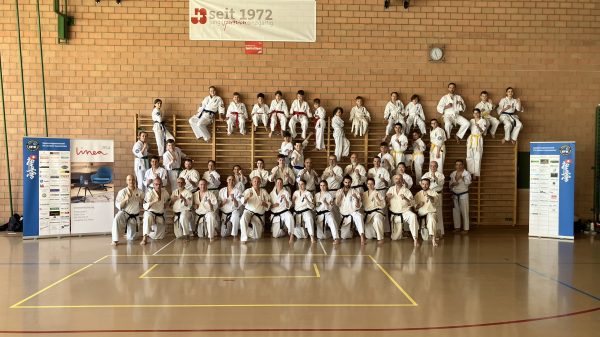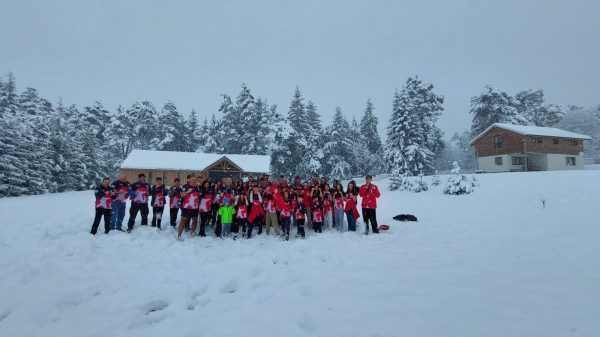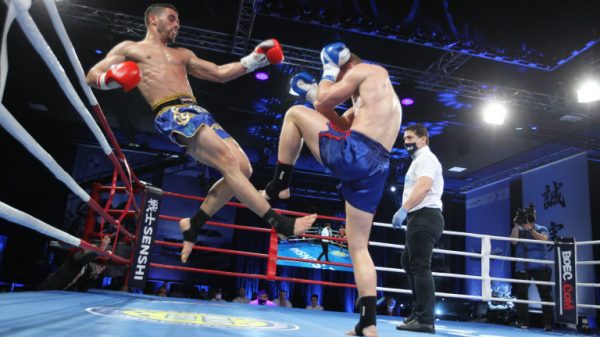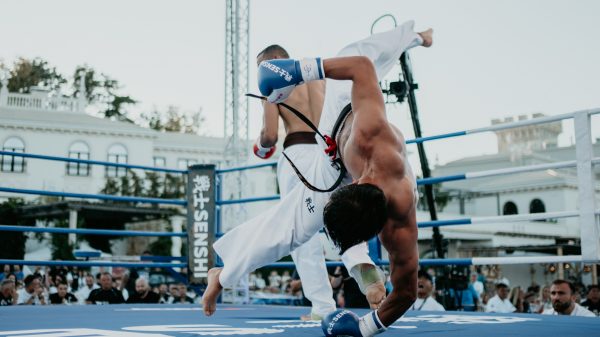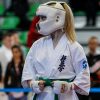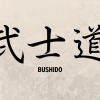KI ( chi ) – inner energy
AI – uniting, joining
KIAI (Kihap or kyap) is the consequence of a special kind of breathing. It is usually said that it is a guttural sound, but the right KIAI comes from the abdomen as a result of strong expiration.
The real KIAI is the consequence of the unconscious part of the human being and it is not deliberately provoked.
KIAI is largely connected to proper breathing because the right KIAI means the proper expiration, and only the proper expiration enables the proper inhalation. Moreover, the contraction of abdominal muscles while exhaling strengthens the trunk, i.e. the pelvis as the axis around which extremities rotate.
The technique of strong guttural expiration was also applied by Zen masters for explaining some ideas to their disciples and they called it KATSU.
Dan Tien is a Chinese name for the central point on the human body, which is located just below the navel and they equate that affects breathing. The Japanese name for the same point is HARA.
The Greek name for this point is pneuma (airflow, breath, or life forces).
By observing human movement or stillness in a short time interval it is possible to see two basic possibilities for man’s relationship to the surroundings in which he finds or doesn’t find support.
The complete expiration lowers the unconscious brunt of the body in the surroundings where we find ourselves, while we strengthen the central part of the body around which peripheral attachments circulate under the impact of the force of muscle contraction. All
the life phenomena are connected to the process of oxidation or reduction, i.e. without oxygen, there is no life.
The supply of our cells depends on blood and oxygen transport by blood.
While contracting, the muscle gets up to ten times more blood than when it rests, thus taking more oxygen and glycogen.
The input of oxygen is just one function of the exhaling function which also covers the rejection of CO2. The cells become free of waste products so that they release them into blood, and this cleansing particularly takes place in the lungs.
To sum up, the complete expiration, i.e. KIAI is the condition without which there is no right and complete inhalation.
The volume of air that the lungs can take is called “the vital capacity”.
The aim of numerous breathing techniques is to enlarge that capacity. Nevertheless, before enlarging it to the maximum we should use the amount we already have as the result of strong expiration (KIAI).
The movements of the diaphragm and the chest speed the venous circulation in the whole organism. The muscles of the diaphragm are ones of the strongest in the human body. The expiration KIAI which consists of AU, AI, OI or EI makes the whole skeleton of the thorax vibrate, which proves that vibrations are transferred to the air mass closed in the lungs so that the gentle membrane of alveoli in contact with the air vibrates stimulating pulmonary cells gases replacement.
The more recent works of Western physiologists report that this vibration has a very noticeable effect on endocrine glands, which science pays more attention to.
It has been proven that the emission of vowels during the exhaling (KIAI) causes a vibratory self-massage of organs. These vibrations reach the deepest tissues and nerve cells enlarging the blood circulation in the organs.
Endocrine glands that send hormones directly into blood and lymph are getting stimulated (the pituitary, the thymus, the adrenal gland, etc.) as well as sympaticus and the brain nerve subject to this useful influence of vocal vibrations.
The vibromassage is particularly important for the organs situated in the thorax and the abdomen. Such vibrations create electromagnetic waves which spread throughout the organism thus enlarging the dynamics of living. Under the impact of this internal vibration, the man gets rid of depression, the inferiority complex, and achieves mental balance.
Practicing martial arts not only relieves and removes depression but also greatly prevents its return. Certainly one of the most effective exercises is the breathing exercise, whether it is a known technique of breathing yoga – pranayama, or similar breathing technique – uyai, or kung-fu breathing technique -chi kung, or karate technique -kokya (aikido, tae kwon do) or breathing technique with the emphasis on exhalation technique – KIAI (kihap). The use of breathing and breath control has a long history in traditional martial arts.
Most martial arts pay attention to a special breathing technique. Such a technique is performed in kung- fu (chi kung, tai chi chuan, pa qua, etc.) in karate (for katas-Sanchin, Tensho, etc.), in tae kwon, do (forms), but also in aikido, hapkido, kendo, judo, and many others. In kendo, for example, a point is only given by the referees if the hit is accompanied by a strong, convincing KIAI. In karate, a KIAI can show that you had the correct intention to score, which is one of the criteria for achieving ippon. For these reasons, it is important to develop a good kiai.
The right breathing implies deep breathing caused by diaphragm and chest movement. It is also important to expire completely, which enables the next complete breath. The right breathing technique is practiced at the very beginning of martial art practice and many trainers emphasize its importance.
The appropriate breathing technique reduces muscle tensions which cause the right muscular distribution. Frequent martial arts practice reduces weight. Obese people have the problem that fat tissues reduce breathing functions and can cause respiratory inflammation.
The breathing technique helps people with depression to relax and calms them down. One of the best ways to breathe is the technique in which a slow inhalation is carried out through the nose while you count up to three, followed by a shorter pause, and a slow-release on the mouth with a count of six. The breathing can be performed so that we breathe first and then later, through the other nostril. Another method of breathing is the more powerful inhalation of the nose, followed by the more powerful exhalation of the mouth. The inhalation is followed by a strong exhalation after which athletes practice various punches that are accompanied by a loud kiai (kihap).
By practicing martial arts trainees strengthen chest muscles thereby improving lung function. This applies not only to the arts; kung-fu, karate, tae kwon do, kendo, and aikido, which in practice require a certain special breathing technique. In other martial arts and skills such as judo, BJJ, sambo, boxing, kickboxing, wrestling, and mixed martial arts and the like, trainees not only develop upper body, especially the arms and shoulders, but also strengthen the muscles of the chest, which positively affects the breathing function.
As the air is coming from the lungs (KIAI) and making the vocal cords vibrate, it completely occupies the consciousness, which results in direct economy of nerve impulses or available energy for other things, and it is the best way to get rid of irritability and get back stability and peace.
After all, doesn’t music provoke various emotions by means of vibrations? Just enough to understand KIAI- the strong shout.
KIAI has got a unique and noted role in martial arts. KIAI is used in the fight while performing strikes, it is used in KATA, as well as in breaking techniques TAMESHIWARI (KYOK PA). Some movements in kata require from the practitioner an exceptional balance, the others endurance, and breathing control. Breathing is here a very important link between physical and mental moves. KIAI is rarely but sometimes used in some styles that use certain internal energy.
Also, the breathing technique while performing the katas (forms) varies across styles. In Karate the breathing is deeper, slower and oriented towards the abdomen (Ibuki), while in many Kung Fu styles the breathing is much faster and more shallow. Certain deviations in the breathing technique exist the same way as in Karate styles and Kung Fu styles. Also, minor but also visible variations in breathing techniques exist even among masters of a certain style which depends on the person. Every master will alter a certain style and breathing technique to his own needs.
KIAI is also applied in self-defense- when we want to intimidate the opponent or encourage ourselves and, therefore, prepare for the fight (spirit yell). Thus the strike and the defense will be more efficient.
KIAI can be rather loud (scream) or on the contrary quite silent (breathing out), it can be longer or shorter depending on a certain person and situation.
In some martial arts the application of the KIAI breathing technique is highlighted in the names of these disciplines, e.g. in China the style TAI CHI (CHI, Japan- KI), in Japan – AIKIDO (AI-KI-DO), IAI DO (KENDO), in Korea – HAPKIDO (HAP-KI-DO) or KUK KI TAE KWON DO, etc.
Therefore, KIAI breathing technique is used in karate, judo, kung-fu, kendo, Ju-Jutsu (KIAI Jutsu), tae kwon do (kihap or kyap), also in wrestling (when throwing the opponent), boxing and kick-boxing (when performing strikes), fencing as well as in lots of other martial arts.
One of the funniest KIAI is in old Maori dance form Haka, but it is certainly KIAI. It is interesting that the strong scream (KIAI) can be heard from various sportspersons not only in martial arts but in other sports, too.
Some examples are athletes (shot putters, javelin throwers, etc.), weightlifters, as well as skiers (when leaving the start). The loud scream (KIAI) can also be noticed in tennis when players run a stronger shot, but it is not the only case.
All of the above goes for the thesis that the real KIAI is not the consequence of willingness to act. On the other hand, it is true that it can be trained and perfected.
As soon as you have started thinking about correct breathing as well as its importance for your body, you have already profited.
Enough to understand KIAI – the powerful shout!
Source: blackbeltmag.com


